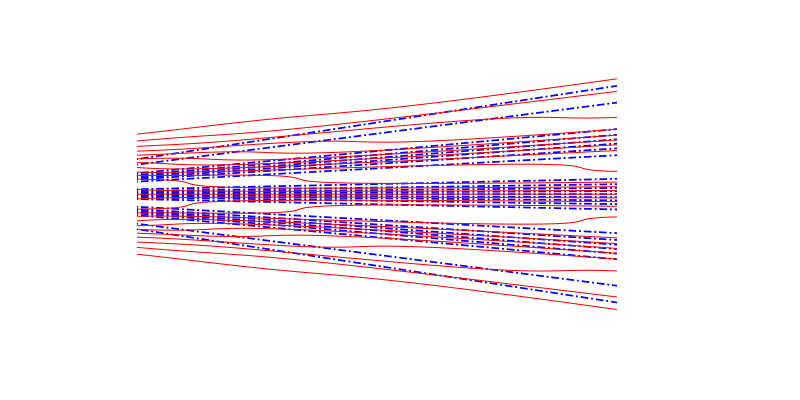Experimental Comparison of Bohm-like Theories with Different Primary Ontologies
1Department of Physics and Centre for Quantum Information Quantum Control, University of Toronto, 60 St George St, Toronto, Ontario, M5S 1A7, Canada
2National Research Council of Canada, 100 Sussex Dr, Ottawa, Ontario, K1A 0R6, Canada
3Canadian Institute for Advanced Research, Toronto, Ontario, M5G 1M1, Canada
| Published: | 2020-11-26, volume 4, page 365 |
| Eprint: | arXiv:1910.13405v3 |
| Doi: | https://doi.org/10.22331/q-2020-11-26-365 |
| Citation: | Quantum 4, 365 (2020). |
Find this paper interesting or want to discuss? Scite or leave a comment on SciRate.
Abstract
The de Broglie-Bohm theory is a hidden-variable interpretation of quantum mechanics which involves particles moving through space along deterministic trajectories. This theory singles out position as the primary ontological variable. Mathematically, it is possible to construct a similar theory where particles are moving through momentum-space, and momentum is singled out as the primary ontological variable. In this paper, we construct the putative particle trajectories for a two-slit experiment in both the position and momentum-space theories by simulating particle dynamics with coherent light. Using a method for constructing trajectories in the primary and non-primary spaces, we compare the phase-space dynamics offered by the two theories and show that they do not agree. This contradictory behaviour underscores the difficulty of selecting one picture of reality from the infinite number of possibilities offered by Bohm-like theories.

Popular summary
► BibTeX data
► References
[1] D. Bohm, Phys. Rev. 85, 166 (1952a).
https://doi.org/10.1103/PhysRev.85.166
[2] D. Bohm, Phys. Rev. 85, 180 (1952b).
https://doi.org/10.1103/PhysRev.85.180
[3] L. de Broglie, J. Phys. Radium 8, 225 (1927).
https://doi.org/10.1051/jphysrad:0192700805022500
[4] P. Holland, The Quantum Theory of Motion (Cambridge University Press, 1993).
https://doi.org/10.1017/CBO9780511622687
[5] J. Gambetta and H. M. Wiseman, Found. Phys. 34, 419 (2004).
https://doi.org/10.1023/B:FOOP.0000019622.81881.f8
[6] C. Philippidis, C. Dewdney, and B. J. Hiley, Il Nuovo Cimento B Series 11 52, 15 (1979).
https://doi.org/10.1007/BF02743566
[7] S. Kocsis, B. Braverman, S. Ravets, M. J. Stevens, R. P. Mirin, L. K. Shalm, and A. M. Steinberg, Science 332, 1170 (2011).
https://doi.org/10.1126/science.1202218
[8] D. H. Mahler, L. Rozema, K. Fisher, L. Vermeyden, K. J. Resch, H. M. Wiseman, and A. Steinberg, Science Adv. 2, 1 (2016).
https://doi.org/10.1126/sciadv.1501466
[9] Z.-Q. Zhou, X. Liu, Y. Kedem, J.-M. Cui, Z.-F. Li, Y.-L. Hua, C.-F. Li, and G.-C. Guo, Phys. Rev. A 95, 042121 (2017).
https://doi.org/10.1103/PhysRevA.95.042121
[10] Y. Xiao, Y. Kedem, J.-S. Xu, C.-F. Li, and G.-C. Guo, Opt. Express 25, 14463 (2017).
https://doi.org/10.1364/OE.25.014463
[11] Y. Xiao, H. M. Wiseman, J.-S. Xu, Y. Kedem, C.-F. Li, and G.-C. Guo, Science Adv. 5, eaav9547 (2019).
https://doi.org/10.1126/sciadv.aav9547
[12] H. M. Wiseman, New Journal of Physics 9, 165 (2007).
https://doi.org/10.1088/1367-2630/9/6/165
[13] T. Pinch, ``What does a proof do if it does not prove?'' in The Social Production of Scientific Knowledge, edited by E. Mendelsohn, W. Peter, and R. Whitley (Springer, 1977) pp. 171–215.
https://doi.org/10.1007/978-94-010-1186-0
[14] S. T. Epstein, Phys. Rev. 89, 319 (1953a).
https://doi.org/10.1103/PhysRev.89.319
[15] S. T. Epstein, Phys. Rev. 91, 985 (1953b).
https://doi.org/10.1103/PhysRev.91.985
[16] For commentary on simulations of massive particles using photons see R. Flack, B. Hiley, Entropy 20, 367 (2018).
https://doi.org/10.3390/e20050367
[17] G. Bacciagaluppi and A. Valentini, Quantum Theory at the Crossroads: Reconsidering the 1927 Solvay Conference (Cambridge University Press, 2009).
https://doi.org/10.1017/CBO9781139194983
[18] D. Bohm and B. J. Hiley, The undivided universe (Routletge, 1993).
https://doi.org/10.1063/1.2808635
[19] D. Bohm, ``Comments on a letter concerning the causal interpretation of the quantum theory [9],'' (1953).
https://doi.org/10.1103/PhysRev.89.319.2
[20] M. Brown and B. Hiley, arXiv preprint quant-ph/0005026 (2000).
arXiv:quant-ph/0005026
[21] P. R. Holland, Phys. Rep. 224, 95 (1993b).
https://doi.org/10.1016/0370-1573(93)90095-U
[22] P. R. Holland, Found. Phys. 28, 881 (1998).
https://doi.org/10.1023/A:1018813112648
[23] W. Struyve and A. Valentini, J. Phys. A: Math. and Theor. 42, 035301 (2008).
https://doi.org/10.1088/1751-8113/42/3/035301
[24] W. Struyve, Found. Phys. 40, 1700–1711 (2010).
https://doi.org/10.1007/s10701-010-9475-6
[25] Y. Aharonov, D. Z. Albert, and L. Vaidman, Phys. Rev. Lett. 60, 1351 (1988).
https://doi.org/10.1103/PhysRevLett.60.1351
[26] B. E. A. Saleh and M. C. Teich, Fundamentals of Photonics, 2nd Edition (Wiley, 2007).
https://doi.org/10.1002/0471213748
[27] N. W. M. Ritchie, J. G. Story, and R. G. Hulet, Phys. Rev. Lett. 66, 1107 (1991).
https://doi.org/10.1103/PhysRevLett.66.1107
[28] J. Dressel, M. Malik, F. M. Miatto, A. N. Jordan, and R. W. Boyd, Rev. Mod. Phys. 86, 307 (2014).
https://doi.org/10.1103/revmodphys.86.307
[29] C. C. Gerry and P. L. Knight, Introductory Quantum Optics (Cambridge University Press, 2004) Chap. 2.
https://doi.org/10.1017/CBO9780511791239
Cited by
[1] Carlos F. Destefani and Xavier Oriols, "Kinetic energy equipartition: A tool to characterize quantum thermalization", Physical Review Research 5 3, 033168 (2023).
[2] Carlos F. Destefani and Xavier Oriols, "Assessing quantum thermalization in physical and configuration spaces via many-body weak values", Physical Review A 107 1, 012213 (2023).
[3] John S. Briggs, "Trajectories and the perception of classical motion in the free propagation of wave packets", Natural Sciences 2 2, e20210089 (2022).
[4] John S. Briggs, "The propagation of Hermite–Gauss wave packets in optics and quantum mechanics", Natural Sciences 4 1, e20230012 (2024).
[5] Devashish Pandey, Rui Sampaio, Tapio Ala-Nissila, Guillermo Albareda, and Xavier Oriols, "Identifying weak values with intrinsic dynamical properties in modal theories", Physical Review A 103 5, 052219 (2021).
[6] David K. Ferry, Xavier Oriols, and Josef Weinbub, "Quantum Transport in Semiconductor Devices; Simulation using particles", Quantum Transport in Semiconductor Devices (2023).
The above citations are from Crossref's cited-by service (last updated successfully 2024-05-14 06:12:29) and SAO/NASA ADS (last updated successfully 2024-05-14 06:12:30). The list may be incomplete as not all publishers provide suitable and complete citation data.
This Paper is published in Quantum under the Creative Commons Attribution 4.0 International (CC BY 4.0) license. Copyright remains with the original copyright holders such as the authors or their institutions.